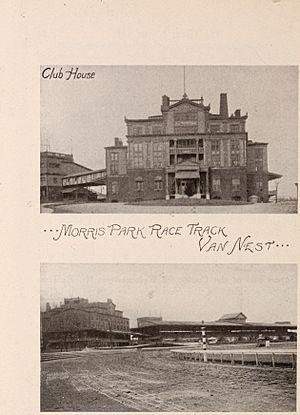Morris Park Racecourse facts for kids
The Morris Park Racecourse was a special place for horse racing in America. It was open from 1889 to 1904. This racecourse was located in a part of Westchester County, New York that later became part of the Bronx in 1895. Today, that area is known as the Morris Park neighborhood. Many famous races happened here, including the Belmont Stakes from 1890 to 1904, and even the Preakness Stakes in 1890.
Contents
History of the Racecourse
The Morris Park Racecourse was created by John Albert Morris. He was the main owner and wanted a new place for horse racing. This happened because the nearby Jerome Park Racetrack was closing down. That old track was being turned into the Jerome Park Reservoir.
John Morris had many businesses. A well-known New York businessman named Leonard W. Jerome loved horse racing and became the president of the new racecourse. On opening day, August 20, 1889, a famous African-American jockey named Isaac Murphy rode here. People said Morris Park was "the finest race track in the world."
It was easy for fans to get to the track. They could come by horse and buggy. The New York, New Haven and Hartford Railroad even built a special short train line. This line took racing fans directly from New York City to the track.
The racecourse also hosted the USA Cross Country Championships several times. These were held from 1890 to 1892 and again from 1897 to 1898.
On June 10, 1890, something special happened. Morris Park Racecourse hosted both the Preakness and Belmont Stakes on the same day! The Preakness Stakes later moved to a different track. However, the Belmont Stakes stayed at Morris Park until 1905. After that, it moved to Belmont Park on Long Island.
During these years (1890-1904), other important races were also held at Morris Park. These included the Champagne Stakes and the Ladies Handicap. The Metropolitan Handicap started here in 1891. The Matron Stakes began the next year.
John Morris leased the racecourse to the Westchester Racing Association in 1895. He passed away shortly after. The track was changed from 1½ miles to one mile. This made it easier for people to watch the races. But not many wealthy people came, so the clubhouse was often empty. By 1902, fewer people were attending races. This led to the decision to close Morris Park Racecourse.
The last day of races was October 15, 1904. Horse racing then moved to the new Belmont Park.
After it closed, the Morris Park Racecourse was used for car races. A few years later, John Morris's family sold the land to people who wanted to build houses. These new owners had money problems. So, the City of New York took over the track in 1907. The city then rented it to the Aeronautic Society of New York. They held the first public air show there. In June 1909, Glenn H. Curtiss showed off his flying skills at Morris Park.
On April 10, 1910, a big fire destroyed many stables and other buildings. Three years later, the land was sold again. Developers bought it to divide into smaller lots for building. As late as 1921, the clubhouse was still standing. It was sold and turned into a factory. This factory made decorative iron items.
What the Racecourse Looked Like
Morris Park Racecourse was a very large area. It was bordered by Sackett Avenue to the south. The Amtrak Northeast Corridor railroad line was also to the south. Williamsbridge Road was to the east. Bronxdale Road was to the west. And Pelham Parkway was to the north.
The main grandstand, where people watched races, was at Bogart and Fowler Avenues. The clubhouse was near Fowler and Van Nest Avenues.
The racetrack covered about 360 acres (1.5 km²). Its grandstand was 650 feet (198 m) long. It could hold up to 15,000 people. The main track was 1½ miles (2.4 km) around. The final straight part of the track was 2,250 feet (686 m) long. It started at 80 feet (24 m) wide and got wider to 240 feet (73 m) at the finish line.
One interesting thing was that the north end of the track was on a hill. This meant horses ran uphill on the backstretch and downhill on the homestretch. There was also a special path called a chute. This allowed 1⅛ mile (1.8 km) races to be run with only one turn.
Another track, called the Eclipse course, ran straight across the main track. It was ¾ mile (1.2 km) long and joined the main track at the finish line. It was named after a horse owned by Francis Morris. A six-furlong race on the Eclipse course was called the "Toboggan Slide." A race with this name is still run today at Aqueduct Racetrack.
The stables at Morris Park Racecourse were huge. They had 1,000 stalls for horses. This was more than any two other American racetracks combined!
Famous Races Held Here
- Belmont Stakes (1890–1904)
- Belle Meade Stakes
- Bouquet Stakes
- Champagne Stakes
- Dixiana Stakes
- Eclipse Stakes
- Hurricana Stakes
- Ladies Handicap
- Laureate Stakes
- Manhattan Handicap
- Metropolitan Handicap
- Matron Stakes
- Municipal Handicap
- New Rochelle Handicap
- New York Jockey Club Handicap
- Pocantico Handicap
- Rancho Del Paso Stakes
- Toboggan Slide
- White Plains Handicap
Other Old Race Tracks in New York
- Brighton Beach Race Course
- Gravesend Race Track
- Jamaica Race Course
- Jerome Park Racetrack
- Roosevelt Raceway
- Sheepshead Bay Race Track
- Union Course


